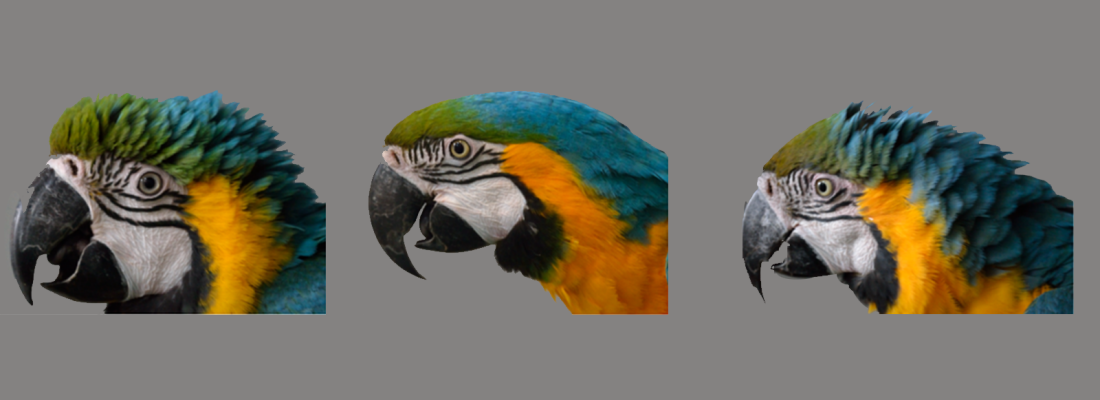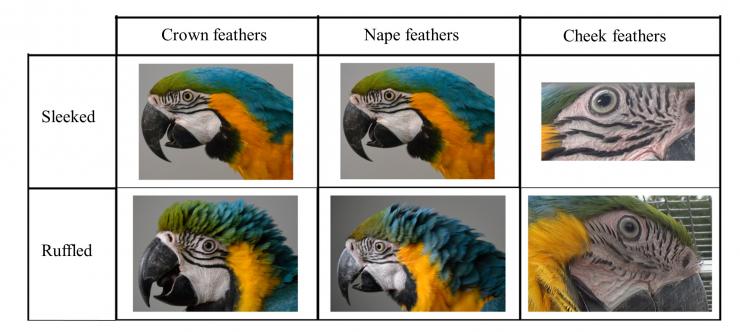Biodiversity Reading time 4 min
Macaws that blush: facial expressions demonstrated for the first time in birds
Published on 22 August 2018

The scientists observed the behaviour of macaws from the Beauval Zoo that are trained on a daily basis by caretakers for a bird show. The birds are therefore in close contact with humans, and a relationship of trust has been forged. To begin with, a list of observable parameters on the birds’ faces was established. The scientists identified three zones where feathers can be ruffled independently: the crown (top of the head), nape and cheeks. They also observed variations in the skin colour on the birds’ cheeks, going from white to red in seconds. Then the scientists used the human-animal relationship to observe these parameters within a context of contrasting emotional valence. The experiments consisted of observing birds during a two-part session: first the caretakers placed the birds on a perch and stood in front of them, interacting with and talking to the animals while looking at them (positive valence for birds). During the control phase, the caretakers kept the same distance from the birds but did not interact with them, turning their backs on the animals (less positive valence).
Each session was repeated ten times for all five birds used in the experiment. The entire experiment was recorded on film, and close-up photographs taken of each bird’s facial profile during and at the end of the sessions. The scientists then deciphered all of the footage and still photography. Naïve observers looked at the photographs and took note of the zone around the birds’ eyes, looking specifically at the colour, white or red. As for the films, they were paused every five seconds so that observers could take note of the position of feathers on the crown, nape and cheeks, according to the established list, i.e. sleek or ruffled.

The findings1showed that ruffled feathers on the crown was more frequent during the phase of mutual interaction between the macaws and their caretakers. Likewise, blushing on the birds’ cheeks – described for the very first time – was more frequently observed during this same interactive phase.

The scientists also observed the birds in groups, in their living environment. They observed more frequent head feather ruffling when the birds were engaged in activities with positive valence and low-arousal levels, such as rest, positive social contact and when given some form of enrichment.
These ground-breaking findings in birds offer the first indicators of arousal level and/or emotional valence, which are key components of the emotional state of animals.
Further study is needed to understand the range of emotions encoded by these facial expressions, and what role they play in the interaction that takes place in social groups. Until now, blushing was thought to be unique to humans. But blushing observed on the cheeks of macaws could contribute to a better understanding of the evolutionary origins and function of this visual indicator.
1 Reference: Bertin A, Beraud A, Lansade L, Blache M-C, Diot A, Mulot B, et al. (2018) Facial display and blushing: Means of visual communication in blue-and-yellow macaws (Ara Ararauna)? PLoS ONE 13(8): e0201762. https://doi.org/10.1371/journal.pone.0201762
Ground-breaking findings in Japanese quail
The results obtained from these macaws incited the INRA scientists to turn their attention to Japanese quail (Coturnix japonica), a model animal used for studying emotions in birds. In order to create contrasting emotional valence, the scientists placed the individual quails, in a more or less fearful state, in an unfamiliar environment with wire mesh on the ground (negative valence). To obtain positive valence, they then opened a sliding door to give the animals access to a ground covered with shavings. This floor covering allows for dustbathing, an activity considered pleasing to birds. The entire experiment was filmed and images were extracted every five seconds for each quail. Using image analysis software, the scientists measured three parameters: the height of feathers on the crown, the angle formed by feathers on the throat, and the surface of pupils.
The hypothesis of the scientists was the following: if facial indicators of positive emotions exist, a broader range of variations of these parameters should be observed in quails that are less fearful (i.e. more apt to evaluate their environment in a positive manner) than in those that are more fearful (i.e. more apt to evaluate their environment in a negative manner). The scientists were able to show crown feather ruffling and dilated pupils in the less fearful quails during the phase when the birds had access to the ground shavings. These variations were not found in the more fearful quails, showing that the subjective experience of animals can be expressed in the movement of crown feathers and the pupil. These ground-breaking findings show facial indicators of positive emotions that have never been observed before.
Crown feather ruffling, observed both in the Psittaciformes and Galliformes orders, suggests that this behaviour could be particularly relevant as an indicator of valence and/or emotional arousal level in a large number of bird species, especially for those lacking a crown and therefore never suspected of having such potential for visual facial communication.
The methodology developed and behavioural indicators highlighted in these studies may serve as a base for further research into the range of emotions that birds can experience according to their living (or shelter) conditions.
Reference: Bertin A. et al., Behavioural Processes (2018), https://doi.org/10.1016/j.beproc.2018.06.015
